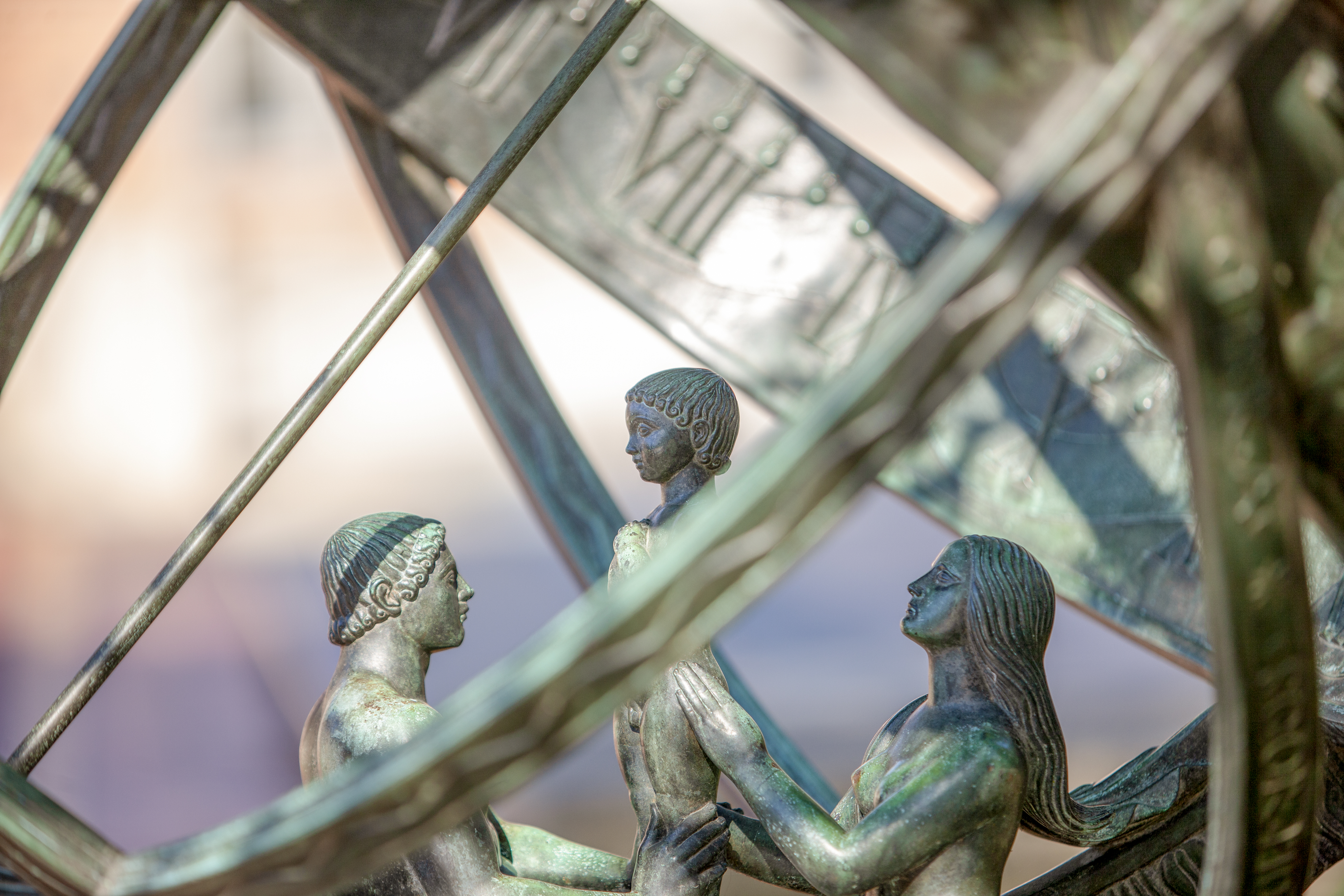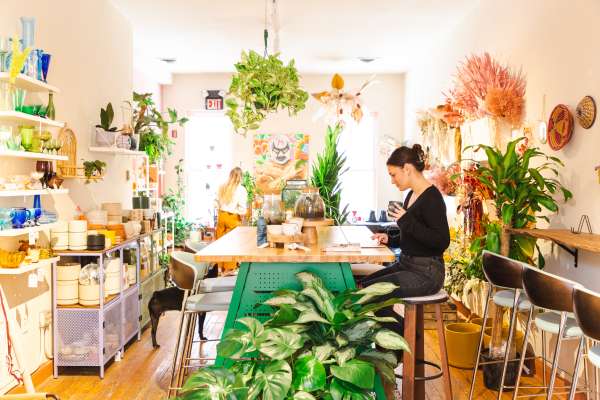A visit to Cranbrook Academy of Art
Almost a century ago, The Cranbrook Academy of Art served as the cradle for mid-century modernism. Today, that unique heritage of innovation is still alive and well on the school’s singular campus, where students and artists follow in the footsteps of some of American design’s greatest pioneers.
A maker imagines a place for makers
Before Cranbrook was a creative home to the likes of Charles and Ray Eames, Florence Schust (later Florence Knoll), Eero Saarinen, or Henry Bertoia, it existed only as the dream of founders George and Ellen Booth.
George Booth was born and raised as a maker in a family of accomplished metalsmiths. When he married Ellen Scripps, he joined one of the wealthiest newspaper families in the United States. Leaving his metalsmithing days behind him to enter the publishing world, George quickly rose to prominence as a leader in the industry.
While this career change took him away from the world of making, George’s love for craft remained. We spoke to Greg Whitkopp, Director of Cranbrook Center for Collections and Research, who explained: “Right around the turn of the century, about 1900, George Booth suddenly has this moment in his 30s when he’s wondering, ‘I’m completely committed to newspapers, but what have I given up? I envisioned that I was always going to be a metalsmith, a maker.’ So, he decides, ‘I’m going to establish an arts and crafts press here in Detroit.’”
 Inspired by the growing arts and crafts movement in Europe, he and Ellen created “The Cranbrook Press,” named after his ancestral home in England. At the same time, the Booths purchased a parcel of land outside Detroit. Hiring famed architect Albert Kahn to design an estate on the property, they began to create a vision for their home to be surrounded by a series of educational and arts institutions.
Inspired by the growing arts and crafts movement in Europe, he and Ellen created “The Cranbrook Press,” named after his ancestral home in England. At the same time, the Booths purchased a parcel of land outside Detroit. Hiring famed architect Albert Kahn to design an estate on the property, they began to create a vision for their home to be surrounded by a series of educational and arts institutions.
The first idea for Cranbrook as an arts school grew out of both the Cranbrook Press and the Detroit Society of Arts and Crafts (which the Booths had recently founded in the city). Initially conceived as a series of arts and crafts studios, the school evolved from a loose collective of art studios to officially open in 1932 as the Cranbrook Academy of Art.
Building a "total work of art"
 For creating the campus, the Booths commissioned Eliel Saarinen, a Finnish architect they had previously hired to complete the Cranbrook School for Boys. Saarinen’s vision for the school as a “total work of art” would distinguish the school as one of the greatest works of American architecture.
For creating the campus, the Booths commissioned Eliel Saarinen, a Finnish architect they had previously hired to complete the Cranbrook School for Boys. Saarinen’s vision for the school as a “total work of art” would distinguish the school as one of the greatest works of American architecture.
A former city planner, Saarinen wanted to create an environment where everything from the layout of campus to the textiles of the furniture would work together as a harmonious whole. In Greg’s words: “Saarinen is thinking at the macro level of the city, the micro-level of a teaspoon, and everything in between.”
The natural context of Cranbrook’s campus was clearly accounted for in Saarinen’s imagining, as the buildings sit comfortably in harmony with the surrounding wooded hills. There’s a remote, monastic feeling to the walkways and exteriors of campus. In contrast, the interior spaces feel open and connected. Student studios seem to flow into their neighbors, with artifacts and projects intermingling at the edges. It seems an apt visual metaphor for the school’s studio culture, where dialogue and cross-pollination of ideas is a key tenet.
 But perhaps the defining trait of the campus arrives in the sense of discovery that emerges throughout. Designed to create an experience of surprise, hidden courtyards, and unexpected architectural details spring up around you.
But perhaps the defining trait of the campus arrives in the sense of discovery that emerges throughout. Designed to create an experience of surprise, hidden courtyards, and unexpected architectural details spring up around you.
For example, in the school’s cafeteria (shared by graduate and prep students alike), each paned window uses a different geometric tesselation.
The subtle variation and interplay of architectural motifs show up throughout the campus.
On this character of the campus, Greg said: “every single day, you can discover a new detail that you had never noticed before. I’ve been here for 33 years. I can guarantee you that if I walked out of the door of Saarinen House today, I could find a detail I’ve never noticed before.”
Working in a design laboratory
 While Cranbrook has had a lauded history, it remains an active, living institution, continuing to push the boundaries of art and design.
While Cranbrook has had a lauded history, it remains an active, living institution, continuing to push the boundaries of art and design.
Rather than being organized with a traditional faculty and course structure, students work independently while being mentored by working artists. We spoke with Scott Klinker, a Cranbrook graduate who is the current designer-in-residence for 3D design. Scott’s previous projects have included collaborations with Herman Miller, Alessi, Steelcase, Burton Snowboards, and others, as well as positions with IDEO and Ericsson.
Working in a studio and post once occupied by Charles Eames, Scott’s role has a unique sense of weight, as he describes: “It can be a challenge, I think, being here now because there are very high expectations. But to me, what made that era so special was that kind of energy that came from the hybridization of design and fine arts and crafts. That’s what Cranbrook has always been good at. That’s why that work happened here. And everything about the culture that produced that energy at that time has continued, and that’s what we still do now.”
 As head of the department, Scott continues to produce design and artistic projects. Working alongside students in the studio, creates a different dynamic than the typical faculty-student relationship. He describes his role as more of a “personal trainer”— helping students to cast a vision and work toward their goals over the course of the two-year degree.
As head of the department, Scott continues to produce design and artistic projects. Working alongside students in the studio, creates a different dynamic than the typical faculty-student relationship. He describes his role as more of a “personal trainer”— helping students to cast a vision and work toward their goals over the course of the two-year degree.
Speaking on what defines the studio culture at Cranbrook, Scott explained: “There’s only 150 students here total, so each person here would graduate with 75 people. You could potentially know every single person that you graduate with. That scale and the proximity of these different disciplines together makes the conditions for a very rare kind of organic exchange. That exchange seemed to be a key goal of the actual design and layout of the studios, and it has absolutely determined the DNA of this place.”
Joe Parr, one of Scott’s students in the 3D design program, chose to come to Cranbrook after being inspired by the history and design sensibility of the school: “When I visited, I just remember it being very open. The campus had this kind of proud, established quality to it. All of the buildings seemed to frame the landscape in a really beautiful way. Everything had its space to be itself.”
Joe has already worked with major manufacturers in the industry, but wanted to hone his skills further through exploration in an environment like Cranbrook. He discovered the school in learning about some of its impressive alumni.
He describes the studio culture: “I think this environment is unique in the sense that you have a lot of autonomy here. We are separate designers all working in the same space with our individual interests and pursuits. So, we are both together and separate. You may be working on something and someone will just wander into your studio and you’ll end up having a conversation that completely changes how you’re looking at something.”
The future of craft
The pioneering spirit of Cranbrook extends beyond just pushing existing media to their limits—it’s also about defining new forms of creative expression.
We sat down with Carla Diana, another Cranbrook graduate who has recently been hired as a designer-in-residence to develop a 4D design program for the school. Our first question was likely the same as yours: what the heck does 4D design even mean?
Carla explains: “4D design is a term that applies to a discipline that is exploring how the world becomes dynamic or changes in time. So, the fourth dimension is time. These projects usually take place through technological interventions.”
During her undergraduate studies at The Cooper Union, Carla studied mechanical engineering before pursuing a 3D design degree at Cranbrook. Her polymathic blend of technical aptitude and design sensibility has led to unique, high-profile robotics projects and smart appliance designs.
 The unique set of skills required for 4D design also broadens the definition of craft, as Carla describes: “So being at Cranbrook where there’s such a history of craft, there will be some new skills and methods front and center for the 4D design student. Soldering pieces of electronics to a circuit board and understanding what that circuit board is going to do is one thing. But these students also will need to be able to program those electronics and understand how the programming is going to affect how a light shines, the color of the light, how a motor moves, how a sound is emitted. All of that is craft, even though it’s something quite new.”
The unique set of skills required for 4D design also broadens the definition of craft, as Carla describes: “So being at Cranbrook where there’s such a history of craft, there will be some new skills and methods front and center for the 4D design student. Soldering pieces of electronics to a circuit board and understanding what that circuit board is going to do is one thing. But these students also will need to be able to program those electronics and understand how the programming is going to affect how a light shines, the color of the light, how a motor moves, how a sound is emitted. All of that is craft, even though it’s something quite new.”
Carla emphasized the importance of helping students develop a holistic approach to digital and technology-driven experiences—focusing on human interactions as a way to ground and guide their work.
The first students will enter the 4D program in the fall of 2019, ushering in a new era of innovative media and technologies for the school. The work being explored by the 4D department would likely be impossible to imagine for its founders, but Carla’s approach feels entirely in their spirit of craft. It’s heartening to know the Booths’ dream lives on in a place that continues to challenge our notions of design.



















